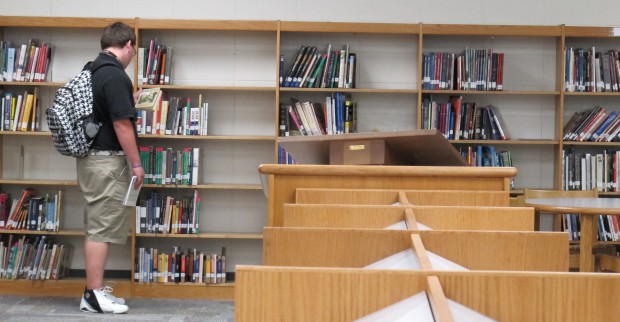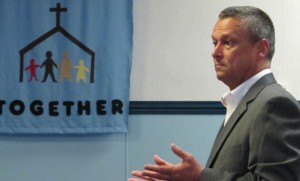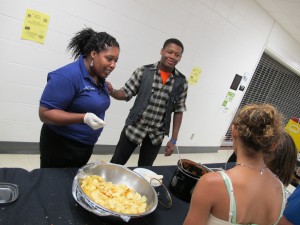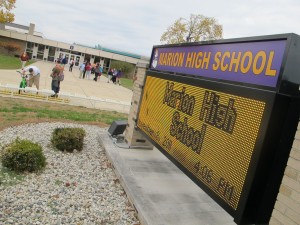Year in Review: 'Failing' Schools, Past and Future

Kyle Stokes / StateImpact Indiana
A student searches for a book at George Washington Community High School in Indianapolis. After six years on the state's failing schools list, education officials are bringing in an outside firm to help improve the school's performance — an intervention short of wholesale takeover.
In 2011, Indiana’s lawmakers and top education officials upped the ante for schools with the state’s lowest test scores, launching takeovers of five “failing” schools in Indianapolis and Gary.
What’s more, the unprecedented moves, along with the direct interventions in two other schools that state superintendent Tony Bennett announced in August, are likely just the beginning.
For struggling districts, the threat of state takeover in 2012 has been made real after the takeovers they saw this year:
- Charter Schools USA, a Florida-based company, will assume control over three Indianapolis Public Schools — Emma Donnan Middle School, Manual High School, and T.C. Howe High School.
- Edison Learning, the New York-based educational company, will take over Gary’s Theodore Roosevelt High School.
- Indianapolis-based EdPower will take control of IPS’s Arlington High School.
Bennett has led the intervention charge, with the blessing of Gov. Mitch Daniels and the state’s legislature.

Kyle Stokes / StateImpact Indiana
Indiana state superintendent Tony Bennett speaks at a meeting addressing the state takeover of Roosevelt High School in a Gary church.
He says the Indiana Department of Education will continue to push for a faster timeline for interventions, which means 100 or more Indiana districts could face state takeover or state-mandated turnaround plan in 2012.
“We don’t really as adults have the time to say ‘let’s compromise their educational experiences.’ So we’re going to push for improved accountability standards in the General Assembly, and we hope to provide proactive interventions sometime in the future,” Bennett said in September.
The Indiana General Assembly could decide whether to give its blessing to a sped-up failing school timeline plan in the 2012 session.
Tensions & Strain
The takeovers proceeded over the forceful objections of Indianapolis Public Schools superintendent Eugene White, who still says he’s “hurt” by the state’s intervention.

Kyle Stokes / StateImpact Indiana
IPS superintendent Eugene White presides over a school board meeting in August.
The IPS Board voted in August to authorize a lawsuit against the state. White and his attorneys felt the measurements state education officials used to determine which schools were eligible for takeover were “discriminatory.”
Three IPS board members voted against authorizing a lawsuit, including Andrea Roof.
“Do I think it sucks? Yes,” Roof said after the vote. “But it’s done, in my opinion.
“It is devastating what’s happening,” Roof continued. “It’s not that I don’t think it won’t be devastating to staff, communities, families, businesses. Devastating. I wish we weren’t in this situation, but we are. My hope now, my personal hope, is for the best for our kids, whatever that may be.”
The district has since backed down on its legal threats.
The ‘Failing’ Label
As we wrote in September, most staff at George Washington Community High School were relieved not to be taken over. In fact, most staff are excited to see how two outside groups the state has appointed to partner with current administrators can help the school.
But just because the school avoided takeover doesn’t mean most staff are okay with Washington, located on the city’s west side, being labeled a “failing” school.
IPS officials and several members of the school’s staff argue the state’s ratings miss a crucial point: community schools, like Washington and three of the public schools facing state takeover, aren’t designed to improve test scores. They’re modeled to improve urban school graduation rates.
Community schools teach middle school and high school-aged students under one roof, offering after school activities and community services — Washington has a community pool, fitness center, and student health clinic. The community school model is based in the idea that if educators can engage an urban student in middle school, they have a better chance of getting that student to graduate from high school.

Kyle Stokes / StateImpact Indiana
Tamika Riggs, who runs the after school program at George Washington Community High School in Indianapolis, serves dinner to students. She says she doesn't have any opinions about politics, but hopes the state's intervention helps kids.
But the catch, administrators freely admit, is that the school does not immediately boost test scores for students in middle school — and in Washington’s case, a decline in middle school test scores was enough to land the school on the Indiana Department of Education’s failing school list again.
Principal Deborah Leser says she feels as though the state’s targets for the school’s performance “are always moving.” This year, the state’s focus on test scores — at the expense of graduation rates — puts Washington at a disadvantage:
Now we’re above the state average on graduation rate, but, we’re still in trouble because our test scores aren’t high enough. Why aren’t our test scores high enough? Well, the change that we made to improve our graduation rate is a change that hurts us on the test scores… We’re showing these big improvements, our kids are performing closer to where they want to be — and they’re not there yet — but in some cases, 30–40 percent higher on their test scores than [at other schools], but we’re on the list.
License To Change?
While in Indianapolis, the threat of further state intervention has aroused suspicion and raised tensions, the reaction has been different in other communities.
As we wrote in November, Marion High School was stuck on the state’s failing schools list and facing a likely takeover.
As a solution, state officials drew up an agreement with Marion superintendent Steve Edwards: Marion High School teachers would submit to annual independent evaluations and work to boost the passage rate on state tests by at least 10 percentage points.
In exchange, the state would help set up programs in the school to mentor teachers while providing them with useful data on student performance.
Test scores improved, school jumped off the failing schools list, and Edwards credits the state’s intervention as instrumental to the school’s turnaround.
“They made my job as a superintendent so much easier. We were gonna tackle these things anyway, but what [state superintendent] Dr. [Tony] Bennett did and what the DOE did was it gave me a license to do some very unpopular things,” Edwards says.
While the fear is that 2012 will bring about a massive wave of state takeovers, Indiana Department of Education officials say that would be logistically impractical, pointing to Marion as an example of something closer to what state intervention will look like in underperforming schools.
“It’s not about ‘gotcha,’” assistant state superintendent Dale Chu told the Indianapolis Star last month.


